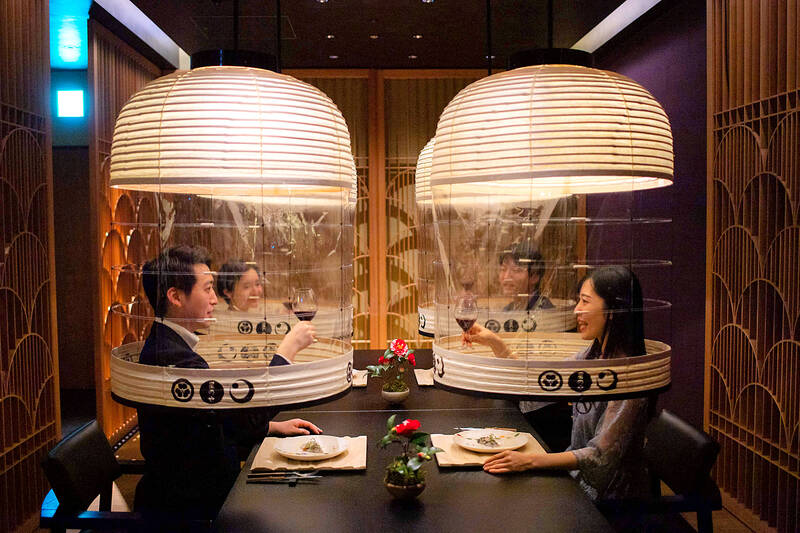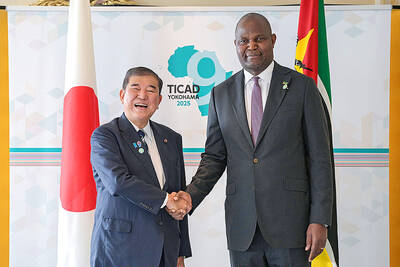It is a linguistic trap few learners of Japanese have avoided: declaring yourself pera pera (fluent in a language) when you’re really peko peko (hungry); or breaking into applause (pachi pachi) when the dentist asks you to kachi kachi (bite repeatedly).
Navigating the rich and varied world of Japanese onomatopoeia can result in laughter and mild embarrassment, but the words can also be a quick and effective way to get through to a friend or colleague.
As Japan’s foreign population reaches record levels, lifted by the arrival of more people to fill a gaping hole in the labour market, volunteers in the western prefecture of Mie have compiled a guide to commonly used onomatopoeic words for language learners.

Photo: AFP
The book, E Kara Oto ga Wakaru Hon (understanding sounds using pictures) was the idea of Masao Hara, the deputy head of a nonprofit in the prefecture whose interactions with non-Japanese convinced him the guide would come in useful.
It contains a host of words that can be used in everyday situations, such as a visit to the doctor, who might hear of their patient’s throbbing (zuki zuki) ankle or pounding (gan gan) headache, a piri piri (stinging) insect bite or muzu muzu (scratchy) throat.
Hara and other members of the nonprofit sifted through a Japanese dictionary to create a list of 100 words, according to the Mainichi Shimbun newspaper.
They are divided into categories — from actions and emotions to the weather and descriptions of inanimate objects — and accompanied by an illustration and descriptions in Chinese, Vietnamese, Nepalese and Indonesian.
Wan Fang, a Chinese resident, said the guide had already made her job at a supermarket a little easier.
“When I was told that the floor was tsuru tsuru in Japanese, I didn’t know what it meant, but when I saw the illustration in the book, I instantly understood that tsuru tsuru means the floor is clean or slippery,” Wan told the newspaper.
The print run of 1,000 copies is expected to find a keen readership among students attending local Japanese language schools — as of January, Mie was home to 31,000 foreign residents. Nationwide, the non-Japanese population reached a record 3.2 million last year, according to the immigration services agency.
The guide only scratches the surface, however. There are said to be more than 1,000 onomatopoeia in Japanese — enough to make most language learners come over all fura fura (dizzy).

Aug. 25 to Aug. 31 Although Mr. Lin (林) had been married to his Japanese wife for a decade, their union was never legally recognized — and even their daughter was officially deemed illegitimate. During the first half of Japanese rule in Taiwan, only marriages between Japanese men and Taiwanese women were valid, unless the Taiwanese husband formally joined a Japanese household. In 1920, Lin took his frustrations directly to the Ministry of Home Affairs: “Since Japan took possession of Taiwan, we have obeyed the government’s directives and committed ourselves to breaking old Qing-era customs. Yet ... our marriages remain unrecognized,

During the Metal Ages, prior to the arrival of the Dutch and Chinese, a great shift took place in indigenous material culture. Glass and agate beads, introduced after 400BC, completely replaced Taiwanese nephrite (jade) as the ornamental materials of choice, anthropologist Liu Jiun-Yu (劉俊昱) of the University of Washington wrote in a 2023 article. He added of the island’s modern indigenous peoples: “They are the descendants of prehistoric Formosans but have no nephrite-using cultures.” Moderns squint at that dynamic era of trade and cultural change through the mutually supporting lenses of later settler-colonialism and imperial power, which treated the indigenous as

An attempt to promote friendship between Japan and countries in Africa has transformed into a xenophobic row about migration after inaccurate media reports suggested the scheme would lead to a “flood of immigrants.” The controversy erupted after the Japan International Cooperation Agency, or JICA, said this month it had designated four Japanese cities as “Africa hometowns” for partner countries in Africa: Mozambique, Nigeria, Ghana and Tanzania. The program, announced at the end of an international conference on African development in Yokohama, will involve personnel exchanges and events to foster closer ties between the four regional Japanese cities — Imabari, Kisarazu, Sanjo and

By 1971, heroin and opium use among US troops fighting in Vietnam had reached epidemic proportions, with 42 percent of American servicemen saying they’d tried opioids at least once and around 20 percent claiming some level of addiction, according to the US Department of Defense. Though heroin use by US troops has been little discussed in the context of Taiwan, these and other drugs — produced in part by rogue Chinese Nationalist Party (KMT) armies then in Thailand and Myanmar — also spread to US military bases on the island, where soldiers were often stoned or high. American military policeman